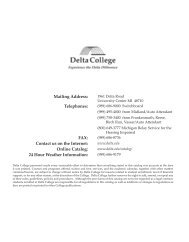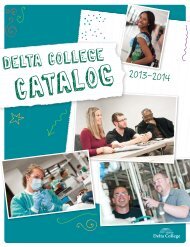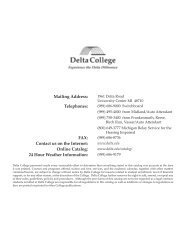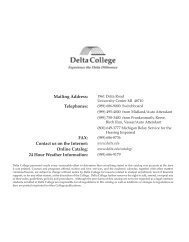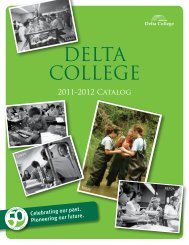2012 - 2013 catalog - Delta College
2012 - 2013 catalog - Delta College
2012 - 2013 catalog - Delta College
Create successful ePaper yourself
Turn your PDF publications into a flip-book with our unique Google optimized e-Paper software.
Introducing <strong>Delta</strong> <strong>College</strong><br />
<strong>Delta</strong> <strong>College</strong> Begins<br />
<strong>Delta</strong> <strong>College</strong> has continued, without interruption, the educational opportunities<br />
that were previously provided by Bay City Junior <strong>College</strong>.<br />
In the mid-1950’s, as the demand for education beyond high school<br />
increased in the tri-county area, the percentage of students attending<br />
Bay City Junior <strong>College</strong> from outside the K-12 Bay City Public School<br />
District steadily increased. The enrollment was approximately 50 percent<br />
non-resident, with about 40 percent of the enrollment coming from<br />
Saginaw. Early in 1955, seven community leaders from Bay, Midland<br />
and Saginaw met to discuss the possibility of a tri-county college. Their<br />
interest and action prompted the following developments:<br />
1955: Organization of the Tri-County Committee of 300 formed to study<br />
the needs of higher education in the Saginaw Valley area.<br />
1956: The final report of the Committee of 300, outlining the need to<br />
establish and finance a new college, was received.<br />
1957: Legislation was submitted to the State of Michigan Legislature to<br />
finance and establish a new institution of higher education.<br />
1957: Voters of Bay, Saginaw, and Midland counties formed a community<br />
college district under Act 182 of the Public Acts of 1957 and authorized<br />
a levy of 1.5 mills to construct and operate a college.<br />
1958: Bonds were sold to provide the financial structure for <strong>Delta</strong> <strong>College</strong><br />
and campus construction began.<br />
1959-61: Members of the faculty and staff of Bay City Junior <strong>College</strong><br />
assisted in planning for the new college. Many of the Bay City Junior<br />
<strong>College</strong> faculty, students, and staff became part of the new college as<br />
Bay City Junior <strong>College</strong> operations were assimilated into <strong>Delta</strong> <strong>College</strong>.<br />
1961: <strong>Delta</strong> <strong>College</strong> opened.<br />
<strong>College</strong> Locations<br />
The <strong>College</strong> main campus is located on a 640-acre campus complex<br />
in Bay County bordered by Hotchkiss, Mackinaw and <strong>Delta</strong> Roads<br />
(please see maps at the back of this <strong>catalog</strong>). Noted for its beautifullylandscaped<br />
center garden, the <strong>College</strong> has miles of nature trails, running<br />
and fitness trails, tennis courts, and archery and golf putting areas, as<br />
well as a covered bridge. The natural surroundings of <strong>Delta</strong> <strong>College</strong><br />
positively enhance the learning process of students. The main campus<br />
site, at University Center, Michigan, lies almost midway between the<br />
three counties’ major cities of Saginaw, Bay City, and Midland. This<br />
triangle forms the heart of the Saginaw Valley area which is drained by<br />
the Saginaw River and its tributaries, northward to the Saginaw Bay<br />
and Lake Huron. Bay County adjoins the Saginaw Bay, an important<br />
recreational area and waterway whose ports are part of the St. Lawrence<br />
Seaway system.<br />
<strong>Delta</strong> <strong>College</strong> has major centers in each of the three counties: <strong>Delta</strong><br />
<strong>College</strong> Planetarium and Learning Center in Bay City; <strong>Delta</strong> <strong>College</strong><br />
Midland Center; and the Ricker Center in Saginaw. The tri-county area is<br />
one of the major concentrations of population within the state. The 2000<br />
population census reports an area population of approximately 399,320.<br />
Sixty-three percent of the people are classified as urban residents, with<br />
44 percent residing within city limits.<br />
Accreditation<br />
<strong>Delta</strong> <strong>College</strong> is accredited by The Higher Learning Commission, A<br />
Commission of the North Central Association of <strong>College</strong>s and Schools<br />
(NCA). Initial accreditation was granted the <strong>College</strong> in October, 1962<br />
by the Michigan Commission on <strong>College</strong> Accreditation. A status study<br />
to prepare for candidacy was submitted to the NCA in May, 1964, as a<br />
first step toward regional accreditation. <strong>College</strong> officials were notified<br />
in July, 1966, that the <strong>College</strong> had been accepted as a candidate for accreditation<br />
based on a report of a NCA visitation team. The Self-Study<br />
Report was completed in May, 1967, and accreditation was granted in<br />
April of 1968. NCA has subsequently reaccredited the <strong>College</strong> in 1973,<br />
1984, 1993, and again in 2003. The <strong>College</strong> has also obtained approval<br />
to offer all Associate degrees online and all online degrees facilitated<br />
by The Michigan Community <strong>College</strong> Virtual Learning Collaborative.<br />
For inquiries regarding accreditation, contact The Higher Learning<br />
Commission, A Commission of the North Central Association of <strong>College</strong>s<br />
and Schools, 30 North LaSalle Street, Suite 2400, Chicago, Illinois<br />
60602-2504; telephone 800-621-7440; fax 312-263-7462; or access the Web<br />
site at www.ncahigherlearningcommission.org.<br />
Several career academic programs also have received additional accreditation<br />
status from their corresponding professional boards, councils, or<br />
regulatory groups.<br />
National League for Innovation<br />
<strong>Delta</strong> <strong>College</strong> is a charter member of the National League for Innovation<br />
in the Community <strong>College</strong>. The League is comprised of 19 League<br />
Board Member college districts with 56 campuses, enrolling more than<br />
750,000 students. Additionally the League has over 750 colleges who<br />
have Alliance membership. <strong>Delta</strong>’s membership is significant recognition<br />
that it is devoted to the improvement of learning through experimentation<br />
and innovation. The League places a strong emphasis on research,<br />
evaluation, and dissemination of information on innovations. In this<br />
way, potentially valuable new approaches to instruction are made known<br />
and an opportunity is provided to judge their suitability for use at other<br />
colleges. Participation in League activities enables <strong>Delta</strong> to adapt and<br />
adopt those innovative practices which have proved effective elsewhere,<br />
while sharing the results of its own innovations with colleges in other<br />
districts. This means that residents of all ages in the tri-counties have<br />
the opportunity to share in the benefits of improved instruction and<br />
services provided by the <strong>College</strong>.<br />
<strong>Delta</strong> <strong>College</strong> <strong>2012</strong>-<strong>2013</strong><br />
9



